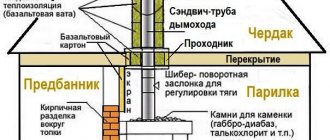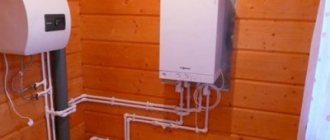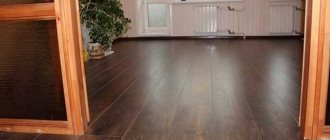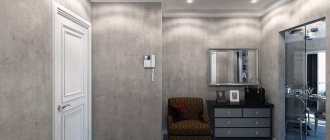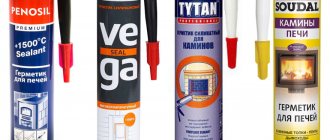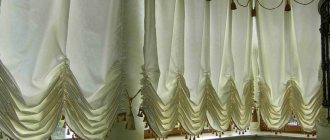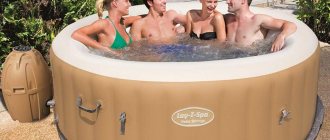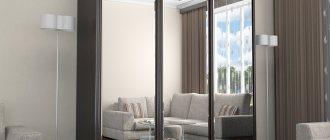The most important stage in finishing any room is insulating the floors. Many people underestimate the amount of heat loss through the floor, but properly selected insulation can save up to 30% of energy on heating. Particularly large savings are achieved when using a heated floor system, which simply needs to be insulated from below so that it does not heat the floors or the ground.
Floor insulation thickness
Choosing the type of insulation that is best suited for your room is only half the battle. It is important that the insulation layer is of sufficient thickness, because even the best insulation will not provide sufficient thermal insulation if it is laid in too thin a layer. On the other hand, an excessively thick layer of insulation reduces the height of the ceilings in the room and is an unjustified waste of money.
Thermal conductivity of some insulation materials
It is important to understand that the required thickness of insulation depends on the climatic conditions in your area. It is obvious that when using the same insulation in houses of the same type in Sochi and Norilsk, completely different layer thicknesses will be required. Therefore, you need to take into account that all the recommendations in the article are given for the typical climate of central Russia, where the temperature in winter rarely drops below -25 degrees. If you live in a milder or more severe climate, then the recommendations need to be adjusted up or down.
Let's consider the main types of thermal insulation and the required layer thickness when used in various types of floors.
Calculation of insulation thickness for underfloor heating systems
Styrofoam
Usually this word refers to foamed polystyrene and extruded polystyrene (penoplex). In terms of chemical composition and thermal insulation properties, these materials are practically the same, however, penoplex has much greater bending strength and resistance to crumbling than traditional polystyrene foam. For this reason, recently most consumers are abandoning foamed polystyrene (foam) in favor of extruded polystyrene (penoplex).
The advantage of this type of thermal insulation is its low price, ease of installation and moisture resistance. The disadvantages include the flammability of this material, and when polystyrene burns, a large amount of toxic substances is released.
Polystyrene slabs are produced in thicknesses from 5 mm to 50 mm; a special chamfer is made on the edges of the slabs so that during installation, gaps and, consequently, “cold paths” do not appear at the joints.
If a layer thickness of more than 50 mm is required, then two or even three layers of polystyrene are laid, with each new layer being laid offset relative to the previous one so that the joints of the slabs of the upper row fall on the centers of the slabs of the lower one.
Screed diagram with foam plastic
When insulating a floor located directly above the ground, the foam layer must be at least 300 mm for a house with a wooden floor, and 200 mm for a house with self-leveling concrete floors. You should lay at least 4 layers of the thickest foam panels, offset from each other.
If there is a cold basement under the floor, then the foam layer can be reduced by 50mm.
To insulate floors between floors of a private house, 150 mm of foam is sufficient for wooden floors and 100 mm for concrete floors.
If you are insulating floors in an apartment building, then for all floors except the first it is enough to lay one layer of foam plastic 50 mm thick. On the ground floor the thickness can be increased to 80-100 mm.
| Index | Polyspen | Polyspen Standard | Polyspen 45 | Control method |
| Density, kg/m3 | 30-38 | 30-38 | 38,1-45 | 5.6 each |
| Bending strength, MPa, not less | 0,4 | 0,4 | 0,4 | 5.8 each |
| Water absorption in 24 hours, % by volume, no more | 0,4 | 0,4 | 0,4 | 5.9 each |
| Thermal conductivity at 25+-5 degrees Celsius, W/m * °C, no more | 0,028 | 0,028 | 0,030 | at 5.10 |
| Toxicity, Hcl 50, g/m3 | T2 moderately hazardous | T2 moderately hazardous | T2 moderately hazardous | at 5.11 |
| Flammability group | G-3 normal-flammable | G-4 highly flammable | G-4 highly flammable | at 5.12 |
| Flammability group | B-2 moderately flammable | B-3 flammable | B-3 flammable | at 5.13 |
| Smoke coefficient | High smoke generating ability | High smoke generating ability | High smoke generating ability | at 5.14 |
| Compressive strength at 10% linear deformation, MPa, not less | 0,2 | 0,2 | 0,3 | 5.7 each |
Calculated thicknesses of Penoplex thermal insulation
Penoizol
This is a liquid version of polystyrene foam, which has the same pros and cons as the solid version. Its advantage is that it can be poured into hard-to-reach places and, after hardening, forms a monolithic coating without seams.
The disadvantages include the fact that you need to think about the method of supplying penoizol for pouring; on high floors this can be a problem. In most cases, penoizol is used during the construction of private houses; when insulating floors in apartment buildings, it is more convenient to use polystyrene foam and penoplex.
The required thickness of the penoizol layer is the same as that of solid foam.
Glass wool and mineral wool
An example of floor insulation with mineral wool
Perhaps this is one of the most budget-friendly options for thermal insulation. In addition to its low price, cotton wool does not burn at all and has good vapor permeability, so it is excellent for insulating wooden floors. This is where the advantages of this material end. The disadvantages include the fact that cotton wool tends to accumulate moisture and this causes rotting and mold growth, the second disadvantage is that over time the wool crumbles if the thermal insulation layer under the floor is not sealed tightly enough, as a result, particles of fibers can pass through the finishing coating become airborne and cause respiratory irritation. Also, wool has very low strength, easily breaks and deforms, which makes it impossible to use it under a concrete screed.
For floor insulation on the ground, rigid mineral wool slabs are recommended
Despite its disadvantages, mineral wool is widely used as insulation, usually in wooden floors.
Most manufacturers produce glass wool and mineral wool in rolls or sheets with a thickness of 50 to 200 mm. Sheets can be laid in several layers with offset joints for better thermal insulation.
To use mineral wool on the first floors located above the ground, very good waterproofing is required. Cotton wool instantly absorbs moisture, after which it loses its thermal insulation properties. For this reason, it is better to use foam plastic for thermal insulation of the first floors. If for some reason it is still necessary to use mineral wool, then its layer should be at least 400 mm.
Multilayer laying of insulation
If there is a basement under the floor of the first floor, then a layer of mineral wool 300 mm thick is sufficient.
When insulating wooden floors between floors of a private house, the layer of wool should be at least 200 mm, and in wooden floors of apartment buildings a thickness of 100 mm is sufficient.
| Name | Advantages | Minuses | Thermal conductivity |
| Sawdust | Cheap, environmentally friendly material, lightweight | Flammability, susceptibility to rotting | 0.090-0.180 W/mK |
| Expanded clay | Eco-friendly, durable material, not subject to rotting, non-flammable | Heavy weight, fragility | 0.148 W/mK |
| Styrofoam | Does not rot, is waterproof, lightweight and easy to install | Low vapor permeability, cannot withstand high temperatures, releases toxins when melted | 0.035-0.047 W/mK |
| Mineral wool | Low thermal conductivity, easy to install, environmentally friendly, fireproof | When moistened, it shrinks and loses its insulating properties. | 0.039 W/mK |
Which material is best?
It’s worth saying right away that there is no single correct answer to this question. Today there is a huge variety of advanced materials that will help insulate the floor. Of course, the choice is yours, because all the offered options differ not only in their appearance, quality characteristics, but also in cost, respectively. Construction experts strongly do not recommend saving on floor insulation, which is why in this article we will consider all the selection criteria, installation features, as well as the possibilities of making the entire range of work as budget-friendly as possible.
Warm floors are the key to comfort and coziness
What should an ideal insulation be like? At a minimum, it must meet the following criteria:
- Safety. The best material for insulation work is the one that is environmentally friendly. Since it will constantly be subject to mechanical and climatic influences, it is important that during operation it does not emit any toxic substances.
- Simplicity and ease of installation. As a rule, construction work related to floor insulation can take from one to three days, depending on the material you choose.
- Resistant to moisture and temperature changes.
- Fire resistant. This criterion is especially important if we are not talking about residential premises, but about floor insulation in industrial enterprises and facilities.
Mineral wool in insulation works
Ecowool
This material is very similar in characteristics to mineral wool, but is made from cellulose fibers, therefore it is absolutely safe for health. Just like mineral wool, ecowool is afraid of water and is easily deformed. Therefore, in most cases it is used to insulate wooden floors between floors.
The big advantage of ecowool is that it is installed by spraying under pressure from a special pipe. Thus, the insulation can be “blown out” under the already assembled floor; for this you only need to make several small technological holes.
The required thickness of the ecowool layer corresponds to the thickness of the mineral wool layer, all other things being equal.
Characteristics of basalt and ecowool
Cork material
The main advantage of natural cork insulation is the extremely high sound insulation of the coating. The high price of the material is compensated by the fact that you simultaneously solve the problem of heat and sound insulation. In addition, cork insulation almost does not burn, is not afraid of moisture, is resistant to rotting and is extremely durable, which allows it to be used as insulation under self-leveling floors.
Due to its rather beautiful texture, cork insulation is sometimes left even as a finishing coating. In this case, the top layer is covered with a special varnish, which protects it and at the same time emphasizes the design.
Cork insulation is available in rolls and sheets with thicknesses from 3 mm to 200 mm. Sheets of maximum thickness allow you to insulate floors above the ground in just one layer, but at the same time they are very expensive. The cost per square meter of thick cork insulation can reach up to 5,000 rubles. For this reason, cork insulation on the first floors of buildings is rarely used.
Cork thermocork insulation
The thickness of cork insulation on the ground floor of a private house with concrete floors should be at least 100 mm; in floors between floors with concrete floors, a layer of 50 mm is sufficient; if the floors are wooden, then the layer should be increased to 70 mm. In an apartment building, cork insulation is laid in a layer of 10 mm to 30 mm; this is quite enough for effective thermal insulation and complete sound insulation from neighbors below.
Video - Cork insulation
Basalt wool is the most suitable option for floor insulation in a wooden house
If you are thinking about choosing a material for thermal insulation work in a wooden house, then pay attention to basalt wool. This option is also distinguished by its availability, but at the same time it has more advantages compared to polystyrene foam. It is worth noting that moisture does not form under the layer of wool, which is extremely important for a wooden floor. That is why insulation can be carried out at any time of the year, and also not only from below the floor base, but also along the joists.
Basalt wool in the form of slabs
Construction experts strongly recommend completely filling the space between the material and the top layer of the subfloor to avoid compromising the insulation. By leaving a gap, wanting to save money, you can end up with only cold from the floor of the first floor. The thickness of the basalt insulation should be at least 250-350 mm. If you decide to carry out similar work on the second floor, attic or attic, then the layer can be made half as thin. In addition, it should also be noted that basalt wool is recognized as an excellent sound insulator, so it can be used for other types of work.
Creating effective thermal insulation
Polystyrene concrete
This is a relatively new material for insulation; it combines the strength of concrete and the lightness of polystyrene. The material has excellent heat and sound insulation properties and at the same time is a durable screed. It is ideal for thermal insulation of large rooms, since it is very easy to pour and level; a team of experienced craftsmen can pour up to 500 m2 of polystyrene concrete per day.
Due to its low weight, polystyrene concrete does not place a large load on the floors, unlike traditional liquid screed. It does not require waterproofing or additional insulation. You can lay tiles or laminate on a thick backing directly on top of polystyrene concrete. To lay soft coverings such as carpet or linoleum, a thin layer of traditional screed, no more than 30 mm thick, is poured over the insulation.
Polystyrene concrete floors are being poured
For effective thermal insulation of the first floors of private houses, 300 mm of polystyrene concrete above the ground is sufficient; if there is a basement under the floor, then the layer can be reduced to 200 mm. 100 mm of insulation is usually poured into the floors between the floors of private houses; in apartment buildings, a layer of 50 mm is sufficient.
| General characteristics of polystyrene concrete | Values |
| Flammability group | G1 |
| Density | from 150 to 600 kg/m³ |
| Frost resistance | from F35 to F300 |
| Strength characteristics | from M2 to B2.5 |
| Coefficient of thermal conductivity | ranging from 0.055 to 0.145 W/m °C |
| Vapor permeability of polystyrene concrete | 0.05 mg/(m h Pa) |
Why do you need to know the dimensions of mineral wool in slabs?
Calculation of the amount of insulation
Positive aspects and properties are ensured by the use of insulation in all areas of construction. To accurately calculate the amount of material for external or internal installation, you will need to know the main standard sizes of slabs in m2 (squares).
When are dimensions taken into account?
Insulating the floor covering inside and creating external thermal insulation begins with drawing up a diagram and purchasing materials. You will need to know the parameters of mineral wool sheets in order to:
- creating thermal protection in accordance with the climate of the region;
- reducing time for budget preparation;
- selection of parameters when laying between floor or attic joists;
- arranging a frame for sheets in the case of external work.
Knowing the dimensions of thermal insulation layers will eliminate the time spent on cutting during installation and the formation of unnecessary joints.
The standard size of the slab is 100x50 cm, but the number of pieces depends on the square footage of the building. The thickness of the material is achieved from 150 to 600 mm. When selecting dimensions, it is necessary to take into account the density indicator - the higher it is, the higher the likelihood of withstanding mechanical loads and the absence of deformation.
Expanded clay
Expanded clay is a popular thermal insulation material used in wooden floors and floors with dry screed based on gypsum fiber board. In the latter case, in addition to thermal insulation, it is also a leveling material.
Expanded clay is one of the cheapest materials for thermal insulation; it does not burn, is safe for health and is lightweight. At the same time, it easily absorbs water, which reduces its thermal insulation properties and significantly increases its weight. Therefore, the use of expanded clay requires reliable waterproofing. Another disadvantage of expanded clay is that when working with it, a large amount of dust rises into the air.
Expanded clay as thermal insulation
In terms of thermal insulation properties, expanded clay is inferior to most synthetic materials, so it requires backfilling with a thicker layer, which reduces the height of the ceilings in the room.
Using expanded clay for insulation. The photo shows expanded clay being poured with lean concrete
For effective thermal insulation of the first floors of buildings from the ground, the expanded clay layer must be at least 400 mm when using wooden floors and 300 mm when using concrete floors.
Between the floors of private houses, at least 200 mm of expanded clay should be poured into the floors for wooden floors and 150 mm for concrete floors. In apartment buildings, a layer of expanded clay of 50-80 mm is sufficient.
| Indicators | 10-20 mm | 5-10 mm | 0-5 mm |
| Bulk density, kg/m3 | 280-370 | 300-400 | 500-700 |
| Crushing strength, N/mm2 (MPa) | 1-1,8 | 1,2-2 | 3-4 |
| Grading, % | 4 | 8 | |
| Frost resistance 20 cycles, gravel weight loss, % | 0,4-2 | 0,2-1,2 | not regulated |
| Percentage of crushed particles, % | 3-10 | 3-10 | No |
| Thermal conductivity, W/m*K | 0,0912 | 0,0912 | 0,1099 |
| Water absorption, mm | 250 | 250 | 290 |
| Specific effective activity of natural radionuclides, Bq/kg | 270 | 270 | 290 |
General characteristics
The product is sold in two forms: slabs and rolls. The dimensions of the sheets are established by GOSTs. In the rolled version, the length of the mat can reach 10 meters, the width - from 1 to 1.5 meters. Slab parameters: 1250*610 mm. Thickness varies from 2 to 15 cm. Density is another important indicator, which indicates the number of fibers per 1 m³. On the packaging it is indicated by the letter P. Values from 35-150 are suitable for working with walls. The higher the value, the greater the load on the base.
Mineral wool in granules
There is also a type of mineral wool called granules. This material itself is not very thick. However, it is poured so that a layer of a certain density and thickness is formed, which depends on where exactly the granules are used.
Typically, this material is used to insulate hard-to-reach places, where it is not possible to install slabs and rolls. Granules are usually blown into cavities using special installations. The ideal option for their use is cavities in ceilings. Densely filling the provided space, the granules form a fairly thick layer of insulation. By the way, its density is 80-140 kg/cubic meter, which makes it possible to use such material for thermal insulation of the attic. The thickness of its layer is calculated for each case individually, based on the characteristics of the project.
Mineral wool differences
As we have already said, there are three types of mineral wool insulation. Each of them is made from different raw materials and has its own properties.
Glass wool
A material consisting of molten glass cullet, dolomite, sand, soda or limestone.
Advantages:
- Breathability.
- Fire resistance.
- Elasticity, vibration resistance.
- Withstands low temperatures.
- Lower cost than other mineral wool.
Minuses:
- Short shelf life - 5-10 years.
- Shrinkage 80%.
- Strongly absorbs moisture.
- If it comes into contact with the skin, it causes itching or even an allergic reaction.
As for the scope of application, it is usually mineral wool for insulating walls inside the house.
Slag
Produced from metallurgical waste. Inferior in characteristics to other types of insulation.
- Does not provide adequate sound insulation.
- Does not withstand strong heat. It does not burn, but it sinteres and loses its thermal insulation qualities.
- Does not tolerate temperature changes.
- Protective clothing and a respirator for installation are also required.
- It is impossible to insulate damp rooms with metal fasteners, since under the influence of moist air, slag will promote corrosion.
- High hygroscopicity.
Plus, such a layer in the wall does not attract rodents and insects. Most often used on dry surfaces of temporary buildings or non-residential buildings.
Stone
The most expensive material. It is usually chosen for exterior work in private houses, including frame wooden houses. Rocks are used in production. Thanks to this, the final product has many advantages:
- High density and therefore strength.
- Fire resistance. Does not ignite at any temperature.
- Minimum shrinkage (5%).
- Long service life (up to 50 years).
- Provides excellent sound insulation.
- Almost does not break during operation, which happens with other types of products.
- Vapor permeability. The fibers repel moisture.
Other materials for insulation
Internet users often ask what the expanded clay layer should be for floor insulation. This indicates a lack of understanding of the purpose of some materials.
The use of expanded clay for insulation
Expanded clay
Over time, this bulk material will shrink and its thickness will decrease.
The thermal conductivity coefficient at a minimum density of 200 kg/m3 is 0.1 W/mC, which according to GOST is sufficient for insulating the external structures of a single-family residential building.
But this is 30% worse than mineral wool.
Expanded clay significantly loads frame floors. It can only be used in a wooden house on floors built on the ground, as a base for a screed.
Ecowool
Another material that belongs to the controversial category is ecowool.
Laying ecowool on a wooden floor
This material is free-flowing and is made by recycling waste paper.
The thermal efficiency coefficient is only slightly inferior to penoizol, but only when using wet spraying.
It does not burn, does not rot, does not attract rodents and is inexpensive. The average price per kilogram is 60 rubles.
If you simply pour ecowool on it, it will not retain heat as effectively. If it is sprayed, the moisture contained in the material will evaporate within 1-2 months, which will lead to rotting of wooden structures.
Our country has not yet developed a unified standard for this material. As a result, manufacturers sell whatever they want. There is no need to talk about any security. And the final cost is high.
For high-quality insulation of a wooden house, you can use natural insulation materials, which are made from flax, coconut, wool, and various trees. They are very effective, environmentally friendly, but expensive.
We recommend reading: insulating the floor of a frame house on stilts.
Advantages and disadvantages of mineral wool for wall insulation
Let's summarize. The advantages of almost all types of mineral wool include several qualities:
- Non-flammability.
- Easy processing. Plates and rolls are cut with a knife or saw.
- Good noise and heat insulation.
- Easy installation.
- Long service life (from 5 to 50 years, except for material made from slag).
- The need to work in protective clothing and a respirator.
- Fiberglass may require additional vapor barrier.
There is also an opinion that when heated, the insulation emits fumes that are harmful to health. Manufacturers claim this is a myth. In addition, after installation, the thermal insulation layer is covered with plasterboard, boards or other finishing.
Particles released into the air when cutting products can be harmful. To do this, it is recommended to close the airways, and if fibers get on the skin, wash them off only with cool or cold water. This is necessary so that the pores do not expand and cutting dust does not get into them.
Overall, this is a modern, easy-to-use, effective material for protecting your home from high and low temperatures.
Advantages and disadvantages
Advantages of basalt wool
Products are supplied wound in a roll and then cut. Mineral wool is suitable for all types of insulation work due to the advantages:
- sound insulation - can be installed in houses near the roadway and production workshops;
- absence of cold bridges - sheets do not shrink at the joints;
- special structure - the fibers are arranged in a chaotic direction or intertwined, which prevents warm air from leaving the room;
- ease of installation - the slabs can be easily cut with a knife or hacksaw on site;
- wear resistance - the insulation retains its properties for 20-70 years;
- environmental friendliness - made on the basis of natural basalt rocks.
The disadvantages of mini-slabs include the difficulty of installation due to high vapor permeability.
How to choose mineral wool products
First you need to pay attention to several characteristics:
- Thickness of mineral wool for wall insulation. The thicker the insulating layer, the higher its fire safety, sound insulation and strength. For interior partitions and frame structures, mats of 5 cm are suitable. For facades - from 5 to 10 cm.
- Density (P). We wrote about it above. The rigidity of the structure and its ability to withstand loads depend on it. For facades, the indicator should be in the range of 100-125 kg/m³. If plaster is chosen as finishing, then 150 kg/m³. For interior partitions - 75-90 kg/m³.
- Thermal conductivity. The smaller it is, the better. In this regard, basalt and fiberglass products have proven themselves well.
- Vapor permeability. The coefficient suitable for private buildings is that of stone wool. Designated MU1. The larger it is, the better the product.
- Fire resistance. The fire resistance level of fiberglass is 600⁰ C, material made of rock alloys is 1000º C.
What else to pay attention to
If you are planning work on the outside of the building, choose basalt slabs. When it is necessary to insulate from the inside, fiberglass coating is also suitable. When purchasing, look at the storage conditions.
- If the product gets even a little wet, there is no point in purchasing it. Check that there are no tears in the packaging.
- Blocks and rolls should be kept under cover and not outdoors.
The most famous manufacturers of mineral insulation are Isover, URSA, Rockwool, Knauf. Their products are certified and quality tested.
How to properly insulate walls with mineral wool
Let's first talk about what can ruin all your work.
Errors in installing mineral wool slabs
- Lack of surface preparation. It should be smooth, clean and treated with an antiseptic (if it is wood).
- Carrying out work during rainfall or leaving finished work unprotected from rain.
- Insufficient application of glue. It is correct when it is distributed over the entire surface, including the perimeter. The most suitable glue is polyurethane foam or dry mixture. The first product is easier and faster to work with, but it is a little more expensive. Both products are resistant to external influences and guarantee good adhesion.
- Unfilled seams between insulation parts. They can only be closed with inserts made of the same material. The maximum gap is 2 mm.
- Intersection of slabs at window and door corners. There should be no joint in these places.
- Lack of mechanical fastenings. Anchors and dowels are used as additional connections for heavy sheets. The optimal quantity is 3-4 pieces per piece (two in the corners, 1 or 2 in the center).
- Smooth mounting, joint to joint. Craftsmen advise installing elements in a checkerboard pattern - this makes it easier to avoid gaps in the structure.
These are the main mistakes that people make when doing thermal insulation at home on their own.
Instructions for insulating the walls of a house with mineral wool from the outside
You will need a metal profile or timber to create the sheathing, accompanying tools for building the frame, a knife or saw, fasteners and a membrane film for vapor barrier. There are two methods. Let's consider one of them. The work is carried out in several stages.
- Surface preparation. You need to remove all old layers of plaster and other finishing from it, clean off dirt and mold, carry out processing and remove all unevenness with a primer.
- Installation of the frame. After the primer has dried, mount the guides at a short distance from the facade - approximately 10-15 cm in increments of 60-100 cm, 1-2 cm less than the width of the block or roll.
- A film is placed under the first layer - with the smooth side facing the stove and the vapor-absorbing side inside. It is attached with double-sided tape or a stapler.
- The first layer of cotton wool is attached on top. Usually a softer one is chosen so that it hides any depressions or bulges if they remain after leveling. The slabs are laid from bottom to top, and the rolls from top to bottom.
- Next, more rigid elements are installed. For reliability, they can be secured with a construction stapler or mushroom dowels.
- Another layer of vapor barrier is placed on top (the film is not stretched), lathing and cladding.
In the case of mounting under a frame, it is important to know in advance the size of the mineral wool insulation for the walls in order to correctly calculate the distance between the profiles.
Insulating the floor with mineral wool involves creating a complex structure to protect the floor from external influences. The resource with a fibrous structure is characterized by high heat and sound insulation properties and ease of use. Knowing the characteristics of the material and installation technology, it is easy to insulate the floor with mineral wool with your own hands.
General information about mineral wool
The term mineral wool means not one, but several different insulation materials, which are made from inorganic raw materials and consist of many microscopic fibers glued together with a binder.
There are three main types of mineral wool. They are presented in the diagram:
Types of mineral wool.
Below I will talk about all of them in more detail, but I will start with the properties inherent in all types of insulation materials described.
Properties of mineral wool
The technical characteristics and operational properties of mineral wool are fixed by several GOSTs:
| Number | Name |
| 9573-96 | Mineral wool slabs with a synthetic binder are thermal insulating. |
| 21880-94 | Stitched mineral wool mats are heat insulating. |
| 22950-95 | Mineral slabs of increased rigidity on a synthetic binder. Technical conditions. |
In addition, many manufacturers are guided by various specifications, which stipulate more stringent standards regulating the production of mineral wool insulation.
I will focus on describing those that are of particular interest from the point of view of use in individual construction:
- Flammability. Unlike common expanded polystyrene, mineral wool belongs to the flammability category NG (non-flammable), while maintaining high heat-protective and sound-insulating properties.
The material has excellent fire-fighting properties.
In addition, cotton wool does not deform when heated to a sufficiently high temperature. Some types of material can be used to construct fire barriers that limit the spread of flames and make it possible to evacuate people or begin to eliminate the source of a fire.
- Thermal conductivity. This indicator must be analyzed taking into account three components: the thermal conductivity of the mineral fibers themselves, the air surrounding them and the liquid penetrating into the mats.
Thermal conductivity of wool in comparison with other materials.
In most cases, the thermal conductivity of a finished mineral mat depends on the size, shape and orientation of the fibers from which it is composed. At the same initial density, the most effective varieties are those in which the fibers are randomly arranged.
To prevent the ingress of liquid that reduces heat-retaining properties, mineral thermal insulation materials are impregnated with hydrophobic substances that facilitate the removal of water when wet.
- Strength. This indicator, like the previous one, also depends on the orientation of individual fibers. The more particles oriented vertically relative to the mat, the greater the compressive strength of the latter. If there is enough vertical fiber, low density board can be used in applications where surface strength is required.
The strength of fiber boards directly depends on their density.
Therefore, when purchasing material, you should choose those manufacturers who use advanced insulation manufacturing technologies, which make it possible to obtain a larger percentage of vertically oriented fibers.
- Shrinkage. The lower the shrinkage coefficient of the material, the greater the likelihood that the structure will retain its original appearance and performance properties.
Mineral wool retains its dimensions throughout its entire service life.
A feature of mineral fiber insulation is the minimum possible percentage of shrinkage, including when heated . The material retains its geometric dimensions throughout the entire service life of the building, ensuring the absence of cold islands that reduce the effectiveness of insulation measures.
- Hygroscopicity. Mineral wool differs from other thermal insulation materials in its low hygroscopicity. Subject to the installation rules and operating conditions, the moisture content inside the basalt mat does not exceed 0.5% of its volume.
The insulation has low hygroscopicity.
To ensure storage of mineral mats before their installation, as well as protection from getting wet during installation and operation, the insulation is additionally treated with organosilicon compounds or oily substances that prevent the accumulation of moisture inside.
- Chemical resistance. Mineral fiber insulation materials are usually chemically neutral. A passive environment is formed inside them, due to which contact with metal parts does not cause corrosion (with the exception of some reservations).
Mineral wool tolerates exposure to most chemicals well.
The performance properties and technical characteristics of the material largely depend on the raw materials from which the fibers are formed. Therefore, next I want to talk to you about the types of mineral wool offered on the market.
Varieties
The very concept of mineral wool is enshrined in GOST number 52953-2008 “Thermal insulation materials and products. Terms and Definitions". According to this regulatory document, three types of fiber insulation are used to insulate homes and engineering structures.
Glass wool
It is made on the basis of melted glass cullet, as well as components used for the production of commercial glass - limestone, borax, sand and soda. After melting and obtaining glass fibers, they are mixed with polymer binders.
Then this mass enters a molding machine, where it is made into mats or rolls, after which it is treated with air heated to a temperature of 250 degrees Celsius. During this treatment, the adhesive substance polymerizes, and the fibers themselves are strengthened and acquire a characteristic bright yellow color.
Glass wool has a characteristic bright yellow color (as in the photo).
For ease of use in construction, glass wool is cut into rolls of a certain length and width, and then packaged in plastic film to avoid destruction of the fibers during transportation.
The thickness of glass wool fibers is 5-15 microns, length 15-50 microns. Typically, wool is formed into mats with a thickness of either 50 or 100 mm, which is enough to provide an insulating layer for a house built in central Russia.
The material retains its technical characteristics and performance properties at ambient temperatures from – 60 to + 450 degrees Celsius. The maximum density of mineral wool for wall insulation is 130 kg per cubic meter.
The advantages of glass wool are as follows:
- low thermal conductivity coefficient λ is from 0.038 to 0.045 W/(m*K);
- cotton wool absorbs sound waves of air and structural origin;
- tolerates exposure to most aggressive chemicals;
- does not burn, does not support the spread of fire and does not emit toxic combustion products;
- does not change its original dimensions throughout the entire service life, regardless of external conditions (except for mechanical impact);
- tolerates many successive cycles of freezing and thawing;
- glass fibers of the material do not absorb liquid;
- The strength of the material is higher than its analogues, which cannot be said about its fragility.
Despite the advantages listed above, glass wool is little used in construction, as it has several disadvantages:
- Fiber fragility. When subjected to mechanical stress, they are destroyed, forming sharp fragments that can cause irritation to human skin and mucous membranes. You can work with glass wool only with respiratory and skin protection.
- Low heat resistance. The material fuses and loses its properties at a temperature of + 450 degrees Celsius, and this is the lowest among all types of mineral wool.
Laying of the material must be carried out in special clothing and using protective equipment.
The material is often used in commercial construction, since its low price allows one to minimize the cost of purchasing building materials. It is used for thermal insulation both inside and outside premises, but with mandatory external decorative finishing.
Slag wool
This material appeared in the middle of the last century as a cheap alternative to the then widespread glass wool. Insulation, as the name implies, is made from metallurgical waste.
The thickness of the fibers ranges from 4 to 12 microns, the length can reach 14. The minimum density of the product is 74 kg per cubic meter, the maximum is 400.
Slag wool is made from blast furnace waste.
The only advantage of this material is its very low cost. However, it does not make it popular, since slag wool has a large number of disadvantages:
- very low melting temperature, which is 300 degrees Celsius, after exceeding which the fibers melt and the insulating layer loses its properties;
- poor heat-retaining properties (thermal conductivity coefficient is only 0.46-0.48 W/(m*K));
- short service life - the material loses its technical characteristics within 10 years after installation;
- high hygroscopicity - slag insulation absorbs water, after which it practically does not fulfill the tasks assigned to it;
- reacts with some building materials, releasing substances that lead to corrosion of metal parts of building structures and utility networks;
- It is characterized by increased fragility (in this indicator it is not inferior to glass wool).
Therefore, I do not recommend purchasing slag wool for insulation, no matter how economically profitable this purchase may seem to you.
Basalt wool
It is made from minerals ejected onto the Earth's surface during volcanic eruptions. Most often we are talking about gabbro-basalt, which has a very high melting point. To form fibers, it is necessary to heat the raw material to a temperature of 1500 degrees.
Basalt wool is a product of processing volcanic minerals.
After processing, basalt produces fibers 3-5 microns thick and 16 microns long. Density can be from 30 to 220 kg per cubic meter.
Thanks to the unique properties of basalt, insulation made from it acquires excellent technical characteristics:
- good thermal conductivity coefficient - it ranges from 0.035 to 0.045 W/(m*K);
- excellent sound absorption capabilities, thanks to which there is no need to install additional soundproofing layers;
- excellent fire-fighting properties - the insulating material melts at a temperature of more than 1000 degrees, so it not only does not ignite, but also serves as a reliable barrier to the further spread of fire;
- has a long service life, during which it retains its original shape and size;
- does not absorb liquid and has water-repellent properties that help remove moisture from the layer of insulating material;
- does not react with chemicals in mortars and has excellent resistance to biocorrosion;
- basalt fibers are not fragile, therefore they retain their integrity during installation (unlike slag and glass wool).
The material is used for thermal insulation of any structures.
The disadvantages include a small emission of formaldehyde, which is present in the resin that glues the fibers. However, during the production process, basalt mats are treated with highly heated air, which neutralizes the binding components, making them safe for the human body.
Areas of application
Mineral wool is popular in both private and commercial construction.
Now let’s figure out where the heat-insulating materials described above can be used. They are suitable for:
- insulation of unloaded surfaces of enclosing structures located vertically, horizontally or at an angle;
- thermal insulation of building facades followed by plastering with thin-layer cement plaster;
- as the main insulating layer when constructing ventilated facades
- used as insulation in layered masonry systems (the insulation is located between two layers of mineral blocks);
- insulation of premises from the inside;
- designing ready-made wall and roof reinforced concrete and metal panels with insulation located between the enclosing layers of the base material;
- thermal insulation of engineering systems for domestic and industrial purposes, insulation of industrial equipment, tanks and warehouses, main pipelines, and so on;
- insulation and sound insulation of flat and inclined exploited and unexploited roofs with the subsequent installation of cement screed or waterproofing materials.
To solve various problems, wool of different densities is used.
In order for the insulation to best perform its tasks, manufacturers produce various types of mineral mats. They have their own characteristics, described in the table.
| Characteristic | Description |
| Soft | They have low compressive strength, so they should not experience loads and are used in frame and multi-layer structures. |
| Semi-rigid, rigid | They are used for thermal insulation of objects where the insulating layer may be subject to loads during installation or operation. Depending on the binder used, they can withstand loads from 5 to 12 kN per square meter. Insulation boards may have grooves to remove condensed moisture, which makes it possible to install them without creating a ventilation gap. |
Semi-rigid and rigid slabs are available in a huge range:
- slabs for thermal insulation of various parts of buildings made of metal, concrete or reinforced concrete - they are usually laid between structural elements;
- products for thermal insulation of rafter supports and floor coverings, when installing them, it is necessary to use a vapor barrier on the side of the heated room;
- windproof boards - they are used in conjunction with soft insulation to protect the latter from loads in wall and roof structures;
- two-layer slabs with layers of different densities - used for arranging ventilated facades (the dense part is located on the outside and protects the soft layer from external influences);
- slabs of increased rigidity - used for thermal insulation of a flat roof in use under mastic or membrane waterproofing;
- special-purpose slabs - as an example, I can cite mineral mats with a slope at a certain angle that helps remove rainwater.
The nuances of floor insulation with mineral wool
When arranging the floor in a private house, fiber insulation is used in the following cases:
- for insulating the base above the basement floor. The basement space is most often not heated, and under the influence of cold air from below, the floor slabs do a poor job of saving heat in the room. As experts note, the cold intensively enters the house through the uninsulated base, which causes the leakage of a considerable part of the thermal energy from the room;
- for heat and sound insulation of interfloor ceilings. Mineral wool in a multi-layer construction of floors between floors is positioned as the optimal thermal insulation option. The use of insulation with a fibrous structure makes it possible to maintain an independent microclimate in rooms located at different levels of the building. The high noise absorption properties of this material help create a reliable barrier against the spread of sound effects, which often occur during the operation of household appliances or utilities;
- for arranging the attic floor. The under-roof space is constantly exposed to aggressive climatic conditions. Seasonal frost or heat, dampness and wind loads negatively affect the condition of the attic floor. To protect the structure from external influences, it is recommended to equip a complex barrier made of mineral wool and hydro- and vapor barrier products.
Mineral wool is available in rolls, slabs and flexible mats with various technical characteristics. Rolled products provide low rigidity, the width of the products is 0.6 and 1.2 m, the length is up to 10 m. The material is relevant when arranging large areas, as it allows you to minimize the number of joints in the heat-insulating layer. To install the rolls, a sheathing is made, and the insulation is laid in two layers.
Mineral wool in slabs
Slabs made of mineral fibers with a dense structure are mainly used for arranging soil foundations. The material is laid without lathing and filled with mortar. Mineral wool in slabs contains hydrophobized components. One side of the product is more rigid than the other. The manufacturer's instructions indicate installation requirements taking into account the characteristics of the product. The factory packaging of tile insulation is designed to cover an area of 1-4 m² in one layer. Dimensions: 50x100 cm.
Features of mineral wool for insulation
Modern construction cannot be imagined without the use of mineral wool as a thermal insulation material. It has a wide range of uses, which makes it especially popular among builders. The most common way to use mineral wool is to insulate building structures.
Typically, mineral wool is used to insulate roofs, floors, walls and ceilings: the dimensions of the materials depend on the area of the room and the type of insulation.
Often mineral wool is used to lay the middle layer. At the same time, the load on the insulation of various types of surfaces in any buildings, houses and structures is avoided. Vertical laying of mineral wool is used to insulate facades and walls. The inclined and horizontal installation method is chosen for insulating the ceiling, roof and roof.
What is mineral wool used for:
- For equipping facade systems that are ventilated, as well as for installation in curtain wall facades.
- Mineral wool is used to insulate building sandwiches of panels and blocks, which are used to build multilayer walls with different types of cladding. They can be metal, concrete, fiberboard and OSB.
- To insulate various industrial structures, equipment and pipelines.
Modern manufacturers offer consumers different types of general building insulation. Cotton wool can be presented as a lightweight heat and sound insulating material that does not have a coating. Another option: cotton wool with one-sided caching using aluminum foil. The wool can be equipped with special sound-absorbing material.
Advantages and disadvantages
The leadership of mineral wool in the environment of floor thermal insulation in the house is determined by the following points:
- high class of non-flammability. An insulator of this category is a barrier to the spread of fires. Varieties of the product are characterized as means of additional fire protection of structures for various purposes. The material is relevant, including when arranging fire-hazardous structures. For example, the operating temperature range of stone wool varies up to +1000°C;
- low thermal conductivity coefficient. The fibrous structure provides an air layer that prevents the transfer of thermal energy. If the installation technology is followed, this type of insulation helps maintain a comfortable microclimate in the room;
- high noise absorption rates. The composition is able to actively resist the propagation of sound waves. Due to its decent sound insulation characteristics, this insulating agent is applicable in various structures, including roofing pie, construction of interfloor ceilings or engineering infrastructures in the house;
- frost resistance. The material is not exposed to negative temperatures and is able to provide maximum protection against heat loss, regardless of the climatic conditions of the area;
- vapor permeability. The composition compares favorably with other insulators by its ability to “breathe”;
- inertness to chemical and biological threats. Insulation based on mineral fibers does not react to the effects of active chemical compounds and pathogens;
- ease of installation. It is convenient to fill any volume of space with mineral wool, since the composition is lightweight and of sufficient thickness;
- efficiency. The material is sold in an affordable segment, which is due to the simplicity of the manufacturing process.
It is convenient to fill any amount of space with mineral wool, as it is light in weight and sufficiently thick
When planning floor insulation with mineral wool, you should know the disadvantages of the resource:
- impressive volume in height. The thickness of the insulating product is of considerable importance when organizing a frame made of wooden logs; this argument negatively affects the overall height of the floor structure;
- exposure to moisture. Not all varieties of mineral wool have moisture-resistant properties. For example, glass wool and slag wool lose their functionality when exposed to a humid environment. Compositions made from volcanic rocks - basalt - are highly resistant to moisture;
- certain difficulties in installation. To work with glass wool and slag wool, you must use special clothing and accessories. It is necessary to avoid direct contact with the composition of small particles with sharp ends that can damage the skin, respiratory tract and eyes.
A big disadvantage is the unsafety of certain types of mineral wool due to the presence of chemical components in the composition. When exposed to high temperatures, compounds are released that are harmful to health and the environment. At the same time, the basalt variety of mineral insulation is quite safe and is used when arranging floors and other structures in the house.
Resources based on mountain volcanic rocks are characterized as effective heat and sound insulation agents. In addition, stone insulator provides high fire resistance, resistance to mechanical loads and moisture. The only disadvantage of basalt insulation is its relative high cost compared to slag and fiberglass.
Material selection criteria
The key criterion for choosing mineral wool for floor insulation is the density of the material. To create a multi-layer base structure when arranging residential premises, priority is given to rolled products with characteristics of 35-40 kg/m³. If you plan to use a tiled insulator, choose a model with parameters up to 90 kg/m³. High-rigidity blocks are also used in industrial facilities.
To insulate a wooden floor, mineral wool in rolls is usually chosen with the calculation of laying in 2 layers. In some cases, it is preferable to use flexible mats with a fibrous structure. Thermal insulation material must be equipped with a vapor barrier membrane and a hydrobarrier in the form of a film.
For concrete floors, preference is given to slabs of appropriate density. If laying under a screed is to be done, rigid models with a density of 150 kg/m³ and the lowest possible thermal conductivity coefficient are used.
For insulation of wooden floors, mineral wool in rolls is mainly chosen
Mineral wool in rolls: types and sizes
The modern market offers a wide variety of all kinds of innovative thermal insulation materials. This includes liquid-ceramic heat insulator, polyurethane foam, and silica mats. However, mineral wool is still the most popular of them.
Mineral wool is characterized by a low thermal conductivity coefficient, a wide temperature range, high fire safety and absolute environmental friendliness.
Rock wool rolls are usually used to insulate horizontal surfaces. This installation requires careful handling and avoidance of too much stress on the surface. Rolls are used to insulate floors between floors, floors, attics, and roofs with a slight slope. They are also used to insulate pipes, fireplace covers and home stoves.
Roll dimensions (width, thickness, length in mm):
- Ursa M-11 – 1150 by 53 by 9000;
- Isover Classic – 1220 by 50 by 8200;
- Isover Sauna – 1200 to 50 to 8200;
- Heat Knauf Dacha - 1220 by 50 by 7380.
Bulk mineral wool is inconvenient to roll, so its thickness usually does not exceed 50 mm. Mineral wool in rolls can be used to insulate large areas where the surface is subject to significant load. For laying rolls, logs, rafters and other building elements are usually used.
Technology and stages of work
The multi-stage process of arranging floor thermal insulation is carried out taking into account the specifics of the technology, which implies a clear algorithm of operation.
Materials and tools
Before starting work, you must prepare the following set of tools and accessories:
- roulette;
- large stationery knife, scissors;
- construction stapler;
- aluminum coated tape.
Tools for dismantling old flooring and repairing/constructing a new multi-layer base structure:
- screwdriver;
- nail puller;
- hammer;
- pliers;
- set of hardware.
You should also ensure that you have protective clothing, a respirator, and goggles. It is necessary to take into account that to work with glass wool and slag wool you will need rubber gloves; other processes are carried out in simple cotton gloves.
Preparatory work
The process begins with removing the old flooring. If you are going to dismantle the finishing layer, which you plan to use again, it is advisable to carefully remove the elements and mark them for ease of re-installation. Next, clean the surface of the subfloor from debris and dust.
Leveling the surface
If, when checking the rough foundation, defects in the form of unevenness, cracks, chips or depressions are revealed, a set of works is carried out to eliminate them. This is necessary to ensure a tight fit of the insulating layer to the surface being constructed. After eliminating the defects of the concrete base, they begin to level the surface using a screed. The modern construction industry offers a wide variety of leveling methods, among which it is not difficult to choose the best option depending on your budget.
Laying vapor barrier
Vapor barrier
After the screed has completely dried to protect the insulation, the concrete base is covered with polyethylene film for vapor barrier. As experts note, a special membrane is a priority for these purposes. The product is a thick canvas made of several layers of waterproofing materials. The vapor barrier is carefully leveled and pressed tightly against the screed, overlapping the wall, taking into account the height of the guides and mineral insulation.
Installation of guides
Thermal insulation of a wooden floor along the joists allows you to lay the mineral wool tightly and evenly, and the pace of work is also accelerated. To install the guides correctly, the following points must be considered:
- the working interval between the logs depends on the parameters of the insulation and the scale of the space being developed;
- preliminary calculations should be carried out to ensure that the gaps between the lags are identical;
- the maximum distance between guides should not exceed 1 m.
Also, gaps between the guides and the perimeter of the wall are not allowed.
Laying mineral wool between joists
Installation of mineral wool
When preparing the insulation, the material is cut with a margin of 1 cm around the perimeter in order to eliminate gaps between the insulator and the joists during installation. Mineral wool is laid in 1 or 2 layers. In this case, the second layer of coating is laid so that the joints of the lower layer are covered with the upper one using the bricklaying method.
Waterproofing
Since the mineral insulator is susceptible to moisture, the next step is to protect the coating with the selected waterproofing agent. This layer is an analogy of a vapor barrier and consists of dense polyethylene.
Finished floor installation

